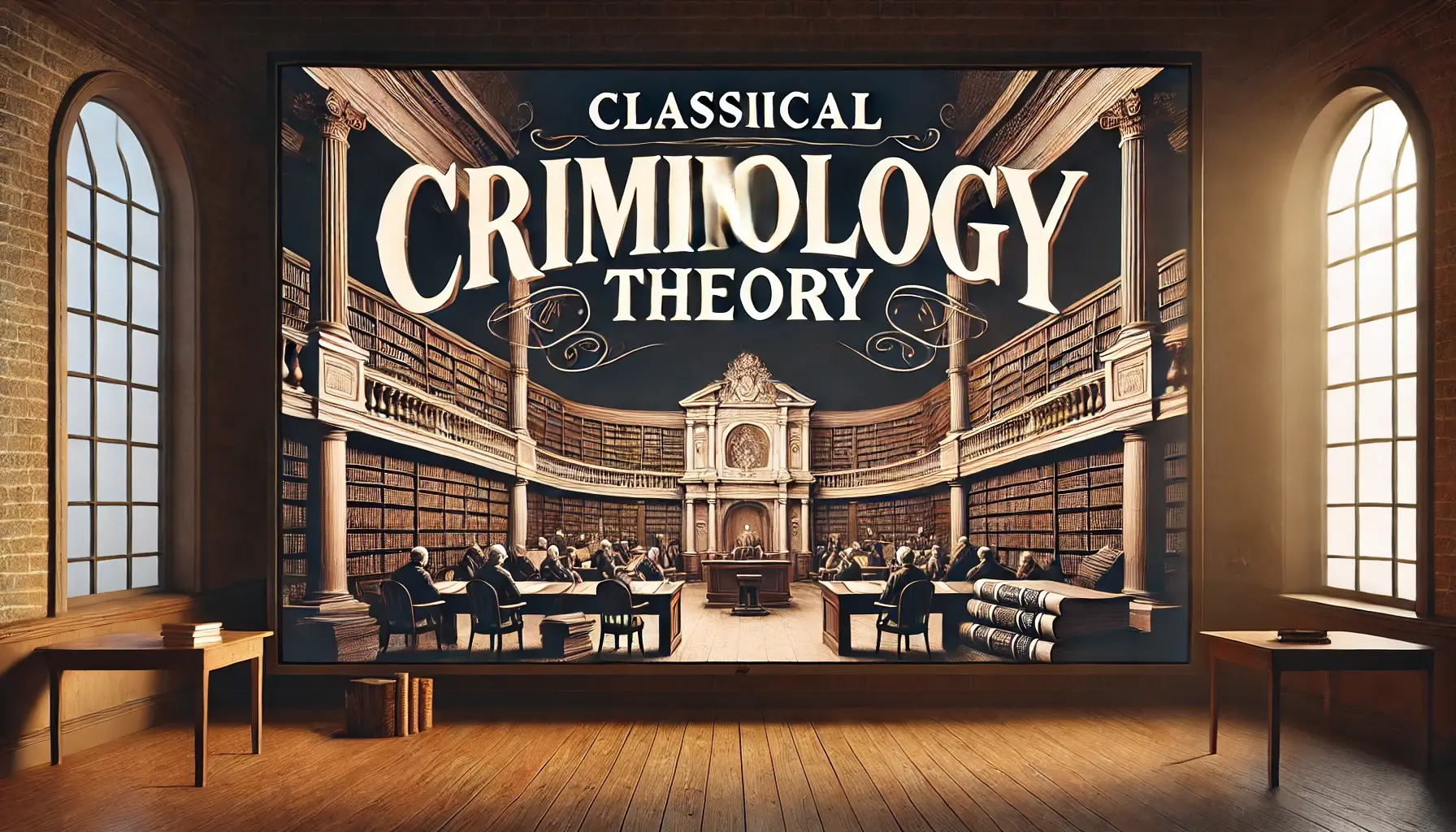Classical Criminology Theory: Origins, Principles, and Impact
Introduction to Classical Criminology Theory
Crime has been a central issue for societies throughout history, leading to the development of various theories to understand and control it. One of the most influential criminological perspectives is Classical Criminology Theory, which emerged in the 18th century Enlightenment Era as a response to the arbitrary and often brutal justice systems of the time. Classical criminology introduced the idea that individuals possess free will and commit crimes based on rational decision-making. This perspective emphasized proportional punishment, deterrence, and the rule of law, influencing modern justice systems worldwide.
The core principles of classical criminology were largely developed by Cesare Beccaria and Jeremy Bentham, who argued that legal systems should be rational, fair, and structured. Their ideas laid the foundation for contemporary criminal justice policies, including structured sentencing and deterrence-based approaches. Despite its impact, classical criminology has been criticized for oversimplifying human behavior and failing to consider social and psychological influences on crime.
This article explores the historical context, key principles, major contributors, critiques, and real-world applications of Classical Criminology Theory, offering an in-depth analysis of its lasting significance in criminal justice.
1. The Historical Context of Classical Criminology
1.1 The Enlightenment Era and the Birth of Rational Legal Systems
The 18th century Enlightenment was a period of intellectual and philosophical growth that emphasized reason, human rights, and social progress. During this time, scholars and legal reformers began questioning traditional justice systems, which were often arbitrary, harsh, and inconsistent. The idea of rational punishment gained momentum, leading to the rise of classical criminology.
1.2 Pre-Classical Perspectives on Crime and Punishment
Before the Enlightenment, crime and punishment were largely dictated by religious and monarchical authority. Some key characteristics of pre-classical justice systems included:
- The belief that crime was caused by supernatural forces or divine punishment.
- The use of torture, execution, and cruel punishments as standard responses to criminal behavior.
- A lack of proportionality between crimes and punishments, leading to excessive penalties for minor offenses.
1.3 The Shift Toward Rationality in Criminal Justice
Enlightenment thinkers sought to replace irrational and oppressive legal systems with logical and proportionate approaches. The movement toward evidence-based justice, fair trials, and standardized laws laid the groundwork for classical criminology.

2. Core Principles of Classical Criminology
2.1 Free Will and Rational Choice
One of the fundamental assumptions of classical criminology is that humans act out of free will. According to this theory:
- Crime is a calculated choice made by individuals based on a cost-benefit analysis.
- People engage in criminal activities when the perceived benefits outweigh the risks.
- Punishment should be designed to alter the cost-benefit equation, discouraging criminal behavior.
2.2 The Concept of Deterrence
Deterrence plays a critical role in classical criminology, aiming to prevent crime through certainty, swiftness, and proportionality of punishment. There are two main types:
- General deterrence: Discourages crime by making examples of punished offenders.
- Specific deterrence: Focuses on preventing a particular offender from reoffending.
2.3 Proportional Punishment and Fair Sentencing
Classical criminology argues that punishment should be proportional to the severity of the crime. Harsh penalties for minor offenses are seen as unjust and ineffective. Instead, laws should be:
- Clear and universally applied, ensuring that individuals understand legal consequences.
- Consistently enforced, preventing arbitrary or biased legal decisions.
- Designed to prevent excessive punishment, aligning with the principles of human rights.
3. Key Thinkers in Classical Criminology
3.1 Cesare Beccaria: The Father of Modern Criminology
Cesare Beccaria (1738-1794) is widely considered the father of classical criminology. His seminal work, On Crimes and Punishments (1764), introduced several groundbreaking ideas:
- Abolition of torture and capital punishment: Beccaria argued that severe punishments were ineffective in preventing crime.
- Certainty over severity: He proposed that the certainty of punishment was more effective than its harshness in deterring crime.
- Equality before the law: Beccaria believed that laws should apply uniformly to all individuals, without favoritism or corruption.
3.2 Jeremy Bentham and the Utilitarian Approach
Jeremy Bentham (1748-1832) expanded on classical criminology through his utilitarian philosophy. Key contributions include:
- The greatest happiness principle: Laws should be designed to maximize societal well-being.
- The Panopticon prison model: A revolutionary design for prisons that allowed constant surveillance to promote deterrence.
- Crime prevention through rational legal policies: Bentham believed in structuring punishments to reduce the overall harm caused by crime.

4. The Impact of Classical Criminology on Modern Criminal Justice
4.1 Influence on Legal Systems
Many contemporary criminal justice systems are rooted in classical criminology principles, including:
- Structured sentencing guidelines that align punishments with crime severity.
- Due process laws that ensure fairness in trials and sentencing.
- Policing strategies focused on deterrence, such as community surveillance and strict law enforcement.
4.2 Crime Prevention Strategies
Deterrence-based approaches inspired by classical criminology include:
- “Three Strikes” laws, which impose harsher penalties on repeat offenders.
- Mandatory minimum sentences to prevent judicial discretion from leading to overly lenient punishments.
- Community policing initiatives aimed at increasing law enforcement presence and reducing crime opportunities.
5. Criticisms and Limitations of Classical Criminology
5.1 Overemphasis on Rationality
Critics argue that classical criminology assumes all individuals act rationally, disregarding factors such as:
- Mental illness and psychological disorders affecting decision-making.
- Impulse-driven crimes, where individuals do not conduct rational cost-benefit analyses.
- Juvenile delinquency, where young offenders may lack full cognitive development.
5.2 Ignoring Socioeconomic and Environmental Factors
Classical criminology largely neglects the role of social and economic influences on crime, including:
- Poverty and unemployment, which contribute to criminal behavior.
- Educational disparities, affecting opportunities for legal economic success.
- Peer influences and family backgrounds, shaping criminal tendencies from an early age.
6. The Evolution into Neo-Classical Criminology
6.1 Addressing the Weaknesses of Classical Theory
Neo-classical criminology emerged to refine classical principles by:
- Incorporating mental health considerations in sentencing.
- Allowing for judicial discretion based on individual circumstances.
- Recognizing that not all crimes result from rational decision-making.
6.2 Modern Applications of Neo-Classical Criminology
Today, criminal justice systems apply a mix of classical and neo-classical principles, leading to:
- Rehabilitation-focused sentencing for certain offenders.
- Diversion programs for youth and first-time offenders.
- Sentencing reforms that balance deterrence with social justice.

Conclusion: The Lasting Legacy of Classical Criminology Theory
Classical criminology remains foundational in criminal justice despite its limitations.
Its emphasis on rationality, free will, and deterrence continues to shape laws, policing, and sentencing worldwide.
Future criminological research should balance classical principles with contemporary understandings of crime to create more effective and humane justice systems.
Classical criminology remains one of the most foundational theories in criminology and criminal justice. Despite its limitations, its emphasis on rationality, deterrence, and proportional punishment continues to shape legal systems worldwide. While modern criminology incorporates additional social, psychological, and economic factors, the core principles of classical criminology remain highly relevant in crime prevention and legal policymaking.







